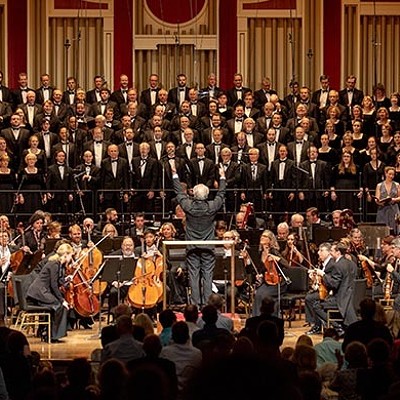
Last Thursday, dressed in gray and black, Roberta Scope didn’t really stand out sitting in the back row of Oakland landmark Rodef Shalom Temple’s towering Levy Hall — except for the bright yellow ribbon pinned to her chest.
She had purchased the twirled strip of cloth to show support for the striking musicians of the Pittsburgh Symphony Orchestra during a free show put on earlier at the Kelly-Strayhorn Theater, in East Liberty. Now in Oakland, Scope was lending her ear to show favor for the striking performers yet again.
“[Symphonies] are always not profitable, but they are important to have in your city,” Scope said, as she waited for a friend before the performance, titled “Music for the Soul,” began.
As the musicians’ work stoppage drags into its sixth week, the strike leaves Pittsburgh’s Heinz Hall devoid of shimmering strings and bellowing brass, echoing only with questions about how and why Pittsburgh’s strike happened.
With negotiations still ongoing at press time, neither the musicians nor PSO management could be reached for comment on this story. Both sides have agreed to a media blackout during negotiations. But labor troubles in concert halls are not limited to the Three Rivers, and they’re not new.
Pittsburgh’s symphonic musicians say they are on strike because of a proposed “15 percent pay cut, a freeze of the Musicians’ pension, and a reduction in the number of musicians,” according to a press release issued by the musicians when the strike started, on Sept. 30. The work stoppage marked the end of a long, fruitless negotiation process that, even after federal mediation, went nowhere since it began in February.
Symphony management has said the cuts are necessary to ensure the group’s long-term survival.
“It is extremely important to underscore that management and the Board of Trustees of the Pittsburgh Symphony are unwavering in our collective commitment to our orchestra’s artistic mission and to its excellence — past, present, and future,” Melia Tourangeau, president and CEO, wrote in a Sept. 30 press release. “At the same time, we must squarely confront the very real financial crisis that we are facing. Throughout the negotiation process — beginning in February and ongoing — we have been doing everything possible to work toward a solution which will place the organization on the best possible path to ensure the orchestra’s future.”
But the strike has already been costly. In addition to canceled symphony performances through Nov. 18, several touring acts, like rocker Elvis Costello and comedians Brian Regan and Lewis Black canceled their shows in solidarity with the striking musicians.
And while labor unrest at the PSO is rare, it’s not unprecedented. The PSO last struck in 1975 — when the Steelers were only one-time Super Bowl champions. David Gillis, a recently retired PSO first violin, recalls that that strike was mostly over pay for the musicians from new media ventures, like recordings for TV and radio.
“[Management was] doing a new model,” Gillis says. “They wanted us to do recordings.”
While these recordings helped “put the symphony on the map,” according to Gillis, management was attempting to “make up rules” about compensating musicians for the recordings. The symphony’s administration wanted to hand-pick the musicians for each recording rather than let the performers distribute the opportunities themselves.
“That was a real sticking point,” says Gillis.
However, even as the orchestra struck to defend its collective rights, the orchestra didn’t seem as “united” in 1975 as it is now, Gillis says. As evidence, he pointed to the many “marvelous” musicians who left the PSO during the strike — some never to return.
“One of the bad parts of the strike in 1975 were the players that we lost,” Gillis says. “The [former PSO] assistant principal bassoonist is still the principal bassoonist at the San Francisco Symphony.”
Andrew Mellor, a music critic who’s written for Gramophone, a classical-music magazine, heard the PSO play on a tour of Europe a few years ago. He has taken in some of the top orchestras in the world from Vienna to Philadelphia. But Mellor still remembers the “huge sense of attitude” and “rampant brass” that defined the PSO.
For instance, he says its rendition of a Gustav Mahler piece made some of its peers’ performances sound “boring.” He did not hesitate to say the PSO was “one of the best in the world.” That makes him concerned about the effect the labor dispute could have on the symphony and its cohesion.
“If enough musicians leave — even if they’re replaced — and the spirit of the orchestra is shattered, that particular sound culture could be under threat,” Mellor says.
However, Mellor doesn’t think that finding the right sound is necessarily related to pay. Noting that European musicians’ salaries are much lower — in the U.K., top orchestras’ musicians make about $50,900, according to The Guardian, or less than half of the base pay of PSO musicians — Mellor says the PSO found its brilliance by “attracting good, talented musicians.”
“[They will need to] fit in and then react to the very special, indefinable sound culture and attitude that [the PSO] orchestra has,” Mellor says.
It’s that breakdown that drives Micah Howard, a double-bass player in the orchestra and the musicians’ negotiation chair, to push back against management’s proposed cuts that he described as “draconian” in a September interview with City Paper.


















